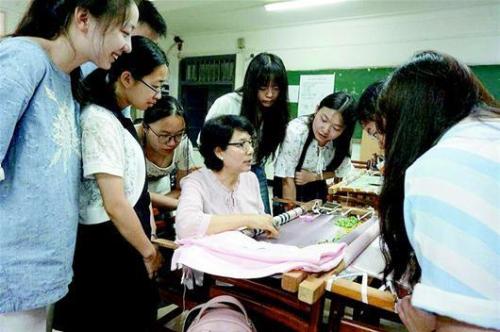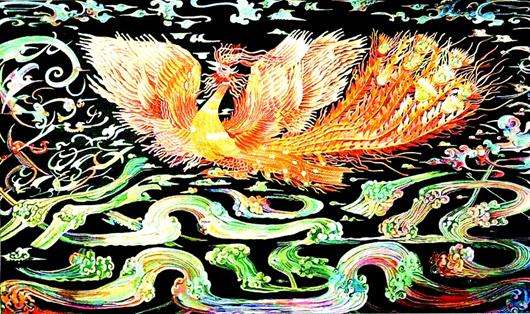


Wang Ziyi with her student (photo/Hubei Daily)
Pull out the embroidery frame, put the embroider cloth in place, then start weaving and stitching, this is how some students at Wuhan University chose to spend their summer holiday: learning Han Xiu (Han embroidery) with Wang Ziyi, a Chinese handicraft master from Hubei province and a Han Xiu inheritor.
Chinese embroidery is one of the most time-honored Chinese arts and crafts. Dating back to the Neolithic Age, Chinese embroidery has gradually gained international fame since the opening of the Silk Road in the Western Han Dynasty (202 BC to 8 AD). An embroidery work usually applies silk, satin, nylon, and colorful silk threads, integrating common themes of Chinese paintings (e.g. flowers, animals, mountains, rivers, human portraits) as the pattern. Although machines are now employed in most cases, some sophisticated artworks are still handmade.
The four major styles of Chinese embroidery are Su Xiu (Suzhou embroidery), Xiang Xiu (Hunan embroidery), Shu Xiu (Sichuan embroidery), and Yue Xiu (Guangdong embroidery), and each are embodied with different geographical features. Han Xiu, also called Chu Xiu (Hubei embroidery), is a lesser known style of Chinese embroidery with distinctive characteristics. Han Xiu emphasizes clearly-layered patterns and sharp colors to present a lively aesthetic.

A Han Xiu product (file photo)
Wang Ziyi started to learn Su Xiu and Xiang Xiu in the 1970s. It was not until 2008 that she got to know Han Xiu, the local embroidery style of Hubei province. Amazed by the geographical features embodied in Hanxiu, Wang soon devoted herself to the protection and popularization of the legacy from her hometown. In 2015, Wang’s Han Xiu work, “Advent of the Phoenix,” won the China’s Arts and Crafts “Hundreds Flowers” Award.
To further promote her beloved embroidery, Wang now runs summer courses on Han Xiu at Wuhan and Jianghan universities in Wuhan, Hubei province. Through lectures and practice sessions, Wang plans to introduce Han Xiu to the students and let them complete their own work within 36 class hours. Students are able to earn a few academic credits if they complete the course.
“Traditional embroidery teaching only focuses on the techniques, what I want to do is to combine traditional techniques with updated designs. I am delighted to see so many students willing to learn a traditional handicraft. They are the future of Han Xiu heritage.” said Wang.
 Fire brigade in Shanghai holds group wedding
Fire brigade in Shanghai holds group wedding Tourists enjoy ice sculptures in Datan Town, north China
Tourists enjoy ice sculptures in Datan Town, north China Sunset scenery of Dayan Pagoda in Xi'an
Sunset scenery of Dayan Pagoda in Xi'an Tourists have fun at scenic spot in Nanlong Town, NW China
Tourists have fun at scenic spot in Nanlong Town, NW China Harbin attracts tourists by making best use of ice in winter
Harbin attracts tourists by making best use of ice in winter In pics: FIS Alpine Ski Women's World Cup Slalom
In pics: FIS Alpine Ski Women's World Cup Slalom Black-necked cranes rest at reservoir in Lhunzhub County, Lhasa
Black-necked cranes rest at reservoir in Lhunzhub County, Lhasa China's FAST telescope will be available to foreign scientists in April
China's FAST telescope will be available to foreign scientists in April "She power" plays indispensable role in poverty alleviation
"She power" plays indispensable role in poverty alleviation Top 10 world news events of People's Daily in 2020
Top 10 world news events of People's Daily in 2020 Top 10 China news events of People's Daily in 2020
Top 10 China news events of People's Daily in 2020 Top 10 media buzzwords of 2020
Top 10 media buzzwords of 2020 Year-ender:10 major tourism stories of 2020
Year-ender:10 major tourism stories of 2020 No interference in Venezuelan issues
No interference in Venezuelan issues
 Biz prepares for trade spat
Biz prepares for trade spat
 Broadcasting Continent
Broadcasting Continent Australia wins Chinese CEOs as US loses
Australia wins Chinese CEOs as US loses